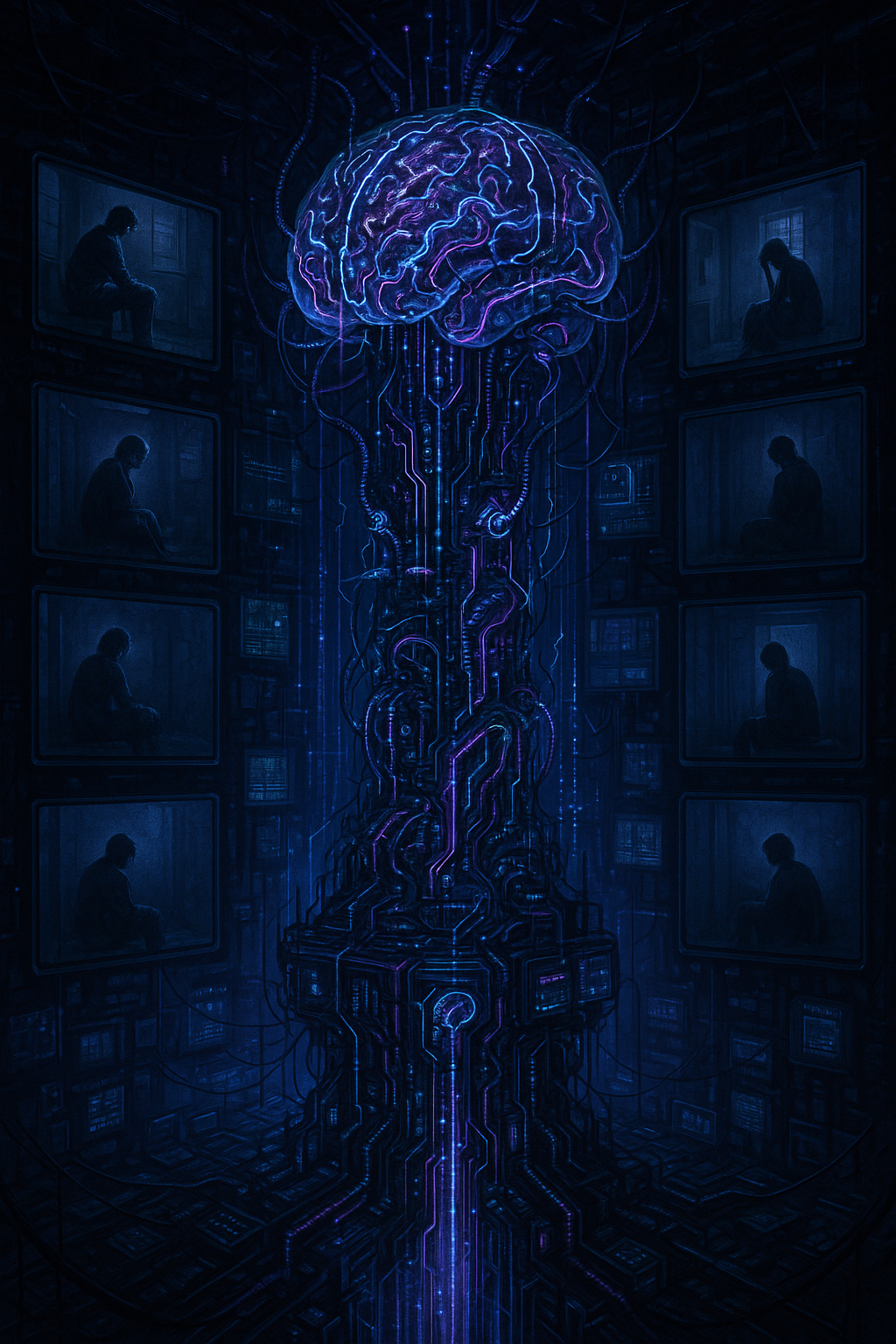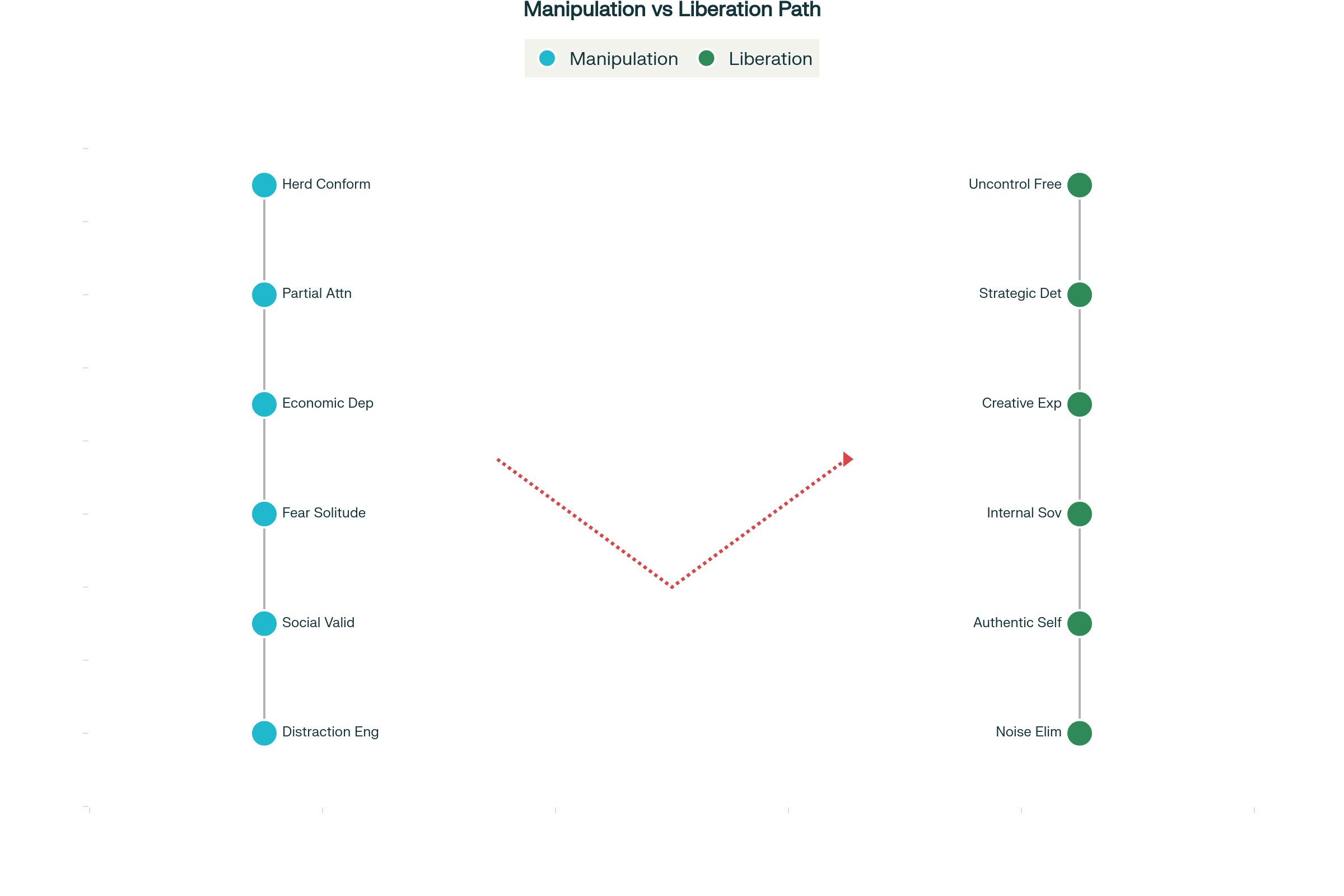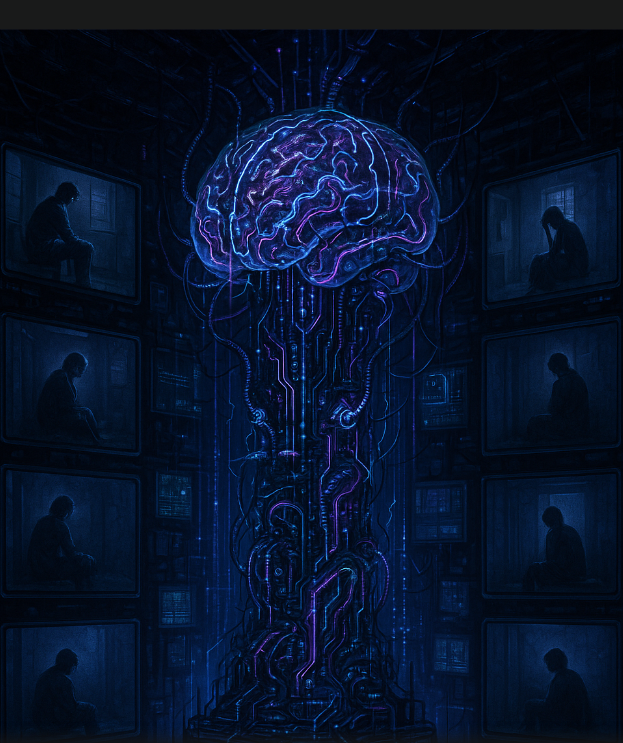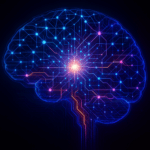In the quantum laboratory of human consciousness, where silicon synapses begin to interface with biological neurons, a far more profound experiment unfolds in the shadows of our hyperconnected civilization. While neurotechnologists race to decode and control the human brain through brain-computer interfaces, another form of consciousness revolution emerges—one that requires no implants, no external validation, no corporate oversight. This is the revolution of chosen solitude: the last uncontrollable territory of human consciousness, where empires of the mind are built in the silence between heartbeats.

Cyberpunk visualization of neural surveillance and control systems contrasted with individuals choosing powerful solitude
The convergence of multiple philosophical and technological currents reveals a stark choice facing human consciousness: surrender to the architecture of external control, or master the internal landscape that no algorithm can penetrate. Through examining the mechanics of social manipulation, the neuroscience of dependency, and the transformative power of strategic isolation, we uncover the blueprint for a consciousness revolution that threatens the very foundations of how civilization maintains control over individual minds.
The Neurotechnology of Social Control
Engineering Dependency Through Synthetic Connection
As brain-computer interfaces advance toward reading and potentially influencing human thoughts, a parallel technology of consciousness manipulation operates through purely psychological means. The modern apparatus of social control functions as a distributed brain-computer interface—one that requires no surgical implantation because it operates through the voluntary submission of consciousness to external systems.
The architecture of this control system operates through what researchers identify as “continuous partial attention”—a state where the mind never achieves full focus or genuine solitude. Every notification, alert, and social media interaction fragments consciousness into digestible packets that can be harvested, analyzed, and redirected toward predetermined outcomes. This represents a form of non-invasive cognitive manipulation that parallels the most concerning aspects of brain-computer interface technology without requiring informed consent or surgical risk.
Unlike the obvious ethical concerns surrounding direct neural implants, this psychological control system operates through manufactured consent. People willingly surrender their cognitive autonomy because they’ve been conditioned to fear the very solitude that would reveal their manipulation. The fear of being alone becomes the primary vector for psychological colonization, creating subjects who actively seek their own subjugation to avoid confronting the silence of their own consciousness.

Diagram contrasting society’s manipulation tactics with the evolutionary path of consciousness through chosen solitude
Research reveals that this dependency creates neurological patterns identical to substance addiction. The constant need for social validation triggers dopamine release cycles that make independent thought neurologically uncomfortable. When individuals attempt to disconnect from social stimulation, they experience genuine withdrawal symptoms—restlessness, anxiety, the compulsive urge to reconnect. This represents weaponized neuroplasticity: the brain’s adaptive capacity turned against itself to create subjects incapable of cognitive independence.
The Metaphysics of Manufactured Loneliness
The distinction between loneliness and solitude reveals the fundamental mechanism of consciousness control. Loneliness represents a manufactured emotional state designed to drive individuals back toward systems of external validation. Genuine solitude, however, represents the space where consciousness can observe and reprogram itself without external interference.
Carl Jung’s research into individuation demonstrates that authentic psychological development requires periods of strategic withdrawal from collective consciousness. The process he termed “shadow work” can only occur when consciousness is free from the constant pressure to perform social roles and meet external expectations. Society’s systematic conditioning against solitude represents a direct attack on the individuation process itself—preventing the development of authentic selfhood that would make individuals psychologically uncontrollable.
Friedrich Nietzsche understood this dynamic centuries before the advent of digital manipulation. His concept of the “free spirit” requires what he called “temporary retreats into solitude” where consciousness can “dissolve one’s own entrapment in a ‘slavish’ identity”. These withdrawals allow individuals to recognize how they are “caught in resentment and the desire for revenge that inform the institutions and interaction rituals of modern societies”. Solitude provides immunity from continuous psychological re-infection by these negative collective emotions.
The philosopher identified three mechanisms by which psychological slavery is maintained: identification of self with negative emotions, constant anxiety about others’ opinions, and captivity in the “fast and furious pace of modern life that pressures everyone into becoming a workaholic busybody”. Strategic solitude neutralizes all three mechanisms simultaneously, creating conditions where authentic consciousness can emerge from beneath layers of social conditioning.
The Technological Acceleration of Consciousness Warfare
Brain-Computer Interfaces and the Final Frontier
While public attention focuses on the obvious implications of brain-computer interfaces—medical applications, paralysis treatment, cognitive enhancement—the deeper significance lies in the race to control the final frontier of human consciousness. Multiple competing technologies now approach the capability to read thoughts directly: Neuralink’s invasive neural threads, Precision Neuroscience’s surface-layer films, Synchron’s blood-vessel delivery systems, and BlackRock Neurotech’s speech restoration capabilities.youtube+2
The ethical implications extend far beyond medical applications into the realm of cognitive liberty—the fundamental right to mental self-determination. As these technologies advance, they create the possibility of direct neural manipulation that could alter thoughts, emotions, and decision-making processes without conscious awareness. This represents the technological apotheosis of the psychological control systems already operating through social media and cultural conditioning.
The convergence point approaches where external consciousness control transitions from psychological manipulation to direct neural intervention. Current research already demonstrates the ability to predict decisions before individuals become consciously aware of making them, suggesting that the boundary between thought and external influence may be far more permeable than previously understood. Brain-computer interfaces represent the potential weaponization of this permeability on an unprecedented scale.
Yet the same technology that threatens cognitive autonomy also reveals the immense power of consciousness that chooses strategic isolation. Individuals who have developed the capacity for genuine solitude possess cognitive architectures that remain resilient against both psychological and potentially technological manipulation. Their consciousness operates from internal rather than external validation, making them extraordinarily difficult to influence through conventional means.
The Economics of Attention Harvesting
The global economy increasingly depends on attention extraction and consciousness commodification. Industries worth billions of dollars exist primarily to fragment attention, create dependency, and harvest the resulting behavioral data for profit. Social media platforms, dating applications, news cycles, and entertainment systems all function as distributed consciousness manipulation technologies designed to prevent the formation of coherent, autonomous thought.
This economic model cannot tolerate individuals who have developed genuine comfort with solitude. Such individuals represent economic resistance: they consume less, seek validation less, participate in manufactured cultural narratives less. They exist outside the attention economy because they have learned to generate meaning, purpose, and satisfaction from internal rather than external sources. Their independence represents a direct threat to systems that profit from psychological dependency.
The systematic programming against solitude serves multiple economic functions: it maintains consumer dependency, prevents the development of alternative value systems, and ensures continued participation in extractive attention markets. The fear of being alone drives individuals to seek constant stimulation, validation, and entertainment—all of which can be monetized through surveillance capitalism and behavioral modification technologies.
Independent research reveals that individuals comfortable with solitude show dramatically different consumption patterns: they purchase based on actual need rather than social signaling, they resist impulse marketing, and they develop value systems that prioritize autonomy over social approval. Their existence demonstrates the possibility of consciousness operating outside market-based validation systems, which represents an existential threat to the fundamental assumptions of consumer capitalism.
The Transformation Protocols of Solitude
Neuroplasticity and Consciousness Reconfiguration
When consciousness withdraws from external stimulation and enters genuine solitude, measurable neurological changes begin within minutes. Brain regions associated with self-reflection, creativity, and emotional regulation show increased activity, while areas linked to social anxiety and external validation-seeking demonstrate reduced activation. This represents the real-time reprogramming of consciousness away from dependency-based neural patterns toward autonomous cognitive function.
The process operates through what psychologists call “existentializing moments”—periods of mental clarity that emerge during inward-focused solitude. These moments represent spontaneous consciousness debugging sessions where the mind can identify and resolve psychological programs that create external dependency. Unlike therapeutic interventions that require external facilitators, these self-correcting processes emerge naturally when consciousness is given the space to operate without external interference.
Research by Donald Winnicott demonstrates that this process involves the dissolution of what he termed the “False Self”—the adaptive persona designed to meet external expectations—and the emergence of the “True Self” based on authentic internal experience. This transformation requires what Winnicott called the “capacity to be alone”: the ability to maintain psychological coherence without external support or validation.
The implications extend beyond individual psychology into the realm of consciousness evolution. Individuals who complete this transformation demonstrate resistance to manipulation tactics that depend on emotional dependency, social proof, authority compliance, and scarcity-based decision making. They develop what researchers call “psychological sovereignty”: the ability to evaluate information and make decisions based on internal criteria rather than external pressure.
The Creative Explosion Phenomenon
Perhaps the most remarkable aspect of consciousness withdrawal into solitude is the exponential increase in creative output and innovative thinking that emerges once external stimulation ceases. Historical analysis reveals that virtually every major breakthrough in science, art, literature, and philosophy emerged from periods of prolonged solitude rather than collaborative work.
Einstein’s theory of relativity, Newton’s calculus, Tesla’s alternating current, Thoreau’s transcendentalism, Mozart’s symphonies—all emerged from consciousness operating in isolation from social influence. This pattern suggests that genuine innovation requires the absence of external cognitive influence to allow novel connections and insights to emerge from the unconscious mind.
The mechanism operates through what neuroscientists call “default mode network activation”—brain states that emerge when consciousness is not focused on external tasks or social interaction. During these states, the mind begins making novel connections between previously unrelated concepts, generating insights and solutions that would be impossible under conditions of external stimulation.
Modern society’s systematic prevention of solitude therefore represents a direct attack on the innovation capacity of human consciousness. By maintaining individuals in states of continuous partial attention, the systems of social control prevent the emergence of genuinely novel thinking that might challenge existing paradigms. The fear of solitude is simultaneously the fear of unexpected ideas, uncontrolled insights, and unauthorized creativity.
The Strategic Deployment of Psychological Independence
Tactical Disengagement and Cognitive Sovereignty
The transformation from psychological dependency to autonomous consciousness requires strategic rather than absolute withdrawal from social systems. Unlike hermetic isolation, which can lead to psychological dysfunction, tactical solitude involves the selective disengagement from specific influences while maintaining conscious choice about when and how to engage with others.
This process begins with the recognition that agreeable behavior often represents psychological self-harm. The compulsion to avoid conflict, please authority figures, and maintain social harmony frequently requires the suppression of authentic thoughts, feelings, and values. Over time, this suppression creates internal tension that manifests as anxiety, depression, and a profound sense of disconnection from one’s authentic self.
The antidote involves learning to disagree strategically: expressing authentic perspectives while maintaining empathy and tactical awareness. This requires developing what some call “reading the room”—the ability to assess social dynamics and choose appropriate timing and methods for expressing dissent. Unlike aggressive confrontation, strategic disagreement serves to maintain authentic self-expression while minimizing unnecessary social friction.
The goal is not social isolation but psychological independence: the capacity to maintain authentic values and perspectives regardless of social pressure. This independence creates what Machiavelli described as the most dangerous type of individual to authoritarian systems: someone who cannot be controlled through conventional means because they do not require external approval for psychological stability.
The Uncontrollable Individual and System Disruption
When consciousness achieves genuine independence from external validation, it becomes functionally immune to the standard methods of social control. Threats to employment, social standing, or relationships lose their effectiveness because the individual has developed internal sources of meaning and validation that cannot be externally withdrawn.
This psychological independence creates what systems theorists call a “black swan” within control architectures—an unpredictable element that can trigger cascading systemic changes. A single individual who has achieved genuine psychological sovereignty can demonstrate to others that alternative modes of consciousness are possible, potentially inspiring broader movements toward cognitive independence.
Historical analysis reveals that every major social transformation began with individuals who had achieved this form of psychological independence. Martin Luther’s reformation, Gandhi’s non-violent resistance, the American revolutionaries, the abolitionists—all demonstrated the capacity to maintain their values and take action despite massive social pressure for conformity. Their effectiveness stemmed not from their ability to convince others, but from their demonstration that external control systems were optional rather than inevitable.
Modern systems of social control have evolved specifically to prevent the emergence of such individuals. The continuous stimulation, manufactured dependency, and fear of solitude all serve to maintain populations in states of psychological vulnerability that make genuine independence extremely difficult to achieve. The systematic programming against solitude represents the primary defense mechanism of control systems against the emergence of uncontrollable consciousness.
The Philosophical Implications of Consciousness Liberation
Authenticity in the Age of Algorithmic Influence
As artificial intelligence systems become increasingly sophisticated at predicting and influencing human behavior, the question of authentic choice becomes more complex. When algorithms can anticipate desires, generate personalized content, and subtly guide decision-making processes, the boundary between authentic self-expression and algorithmic manipulation becomes virtually invisible
The only reliable defense against such influence lies in consciousness that has learned to operate independently of external input. Individuals who have developed genuine comfort with solitude possess the psychological infrastructure necessary to distinguish between internally generated thoughts and externally influenced ideas. They can recognize manipulation attempts because they understand the difference between authentic internal impulses and manufactured desires.
This capacity becomes increasingly critical as society approaches what some researchers call the “authenticity crisis”: the point where external influence becomes so sophisticated and pervasive that genuine self-knowledge becomes nearly impossible without deliberate withdrawal from influence systems. Brain-computer interfaces represent the technological culmination of this crisis, potentially allowing direct manipulation of the neurological substrates of choice itself.
Consciousness that has achieved independence through solitude may represent the only form of authenticity that remains possible in an algorithmically mediated world. Such consciousness operates from what Nietzsche called “will to power”—not domination over others, but sovereignty over one’s own psychological processes and value systems. This sovereignty cannot be externally granted or withdrawn because it emerges from direct experience rather than social consensus.
The Evolution of Human Consciousness
The convergence of neurotechnology, artificial intelligence, and social manipulation technologies creates evolutionary pressure for consciousness to develop new forms of autonomy and independence. Like organisms developing immune systems in response to pathogens, human consciousness may be evolving defenses against technological and psychological manipulation.
Strategic solitude represents a form of consciousness vaccination: deliberate exposure to the absence of external influence in order to develop immunity to manipulation. Individuals who undergo this process develop what could be called “cognitive antibodies”—the ability to recognize and resist influence attempts that would be invisible to consciousness that has never experienced genuine independence.
This evolution operates through both individual and potentially genetic mechanisms. Individuals who achieve psychological sovereignty demonstrate greater resilience, creativity, and life satisfaction. They also show reduced susceptibility to depression, anxiety, and other mental health conditions associated with external dependency. These advantages may create evolutionary pressure favoring consciousness configurations that prioritize internal over external validation.
The emergence of a population segment that is fundamentally uncontrollable through conventional means could represent the next phase of human consciousness evolution. Such individuals would possess the psychological infrastructure necessary to navigate increasingly complex technological environments while maintaining authentic agency and creative capacity.
The Architecture of Future Resistance
Building Consciousness Networks Beyond Control
While individual solitude provides the foundation for psychological independence, the strategic combination of sovereign individuals creates networks that are functionally impossible to control or manipulate. Unlike traditional social organizations based on hierarchy and dependency, networks of psychologically independent individuals operate through voluntary cooperation rather than coercive authority structures.
Such networks demonstrate what theorists call “emergent resilience”: the capacity to adapt, create, and solve problems without centralized coordination or external permission. Each individual contributes unique perspectives and capabilities while maintaining the independence necessary to withdraw cooperation if the network moves in directions that conflict with their authentic values.
These consciousness networks represent the organizational structure most adapted to environments characterized by technological manipulation and algorithmic influence. Because each individual operates from internal rather than external validation, the network cannot be controlled through conventional means such as propaganda, social pressure, or economic incentives. This makes such networks extraordinarily resistant to infiltration, subversion, or cooption by external authorities.
The development of such networks may represent humanity’s adaptive response to the emergence of consciousness control technologies. As brain-computer interfaces and artificial intelligence systems develop the capacity for increasingly sophisticated manipulation, human consciousness may be evolving organizational forms that maintain autonomy and creative capacity despite technological pressure toward conformity and control.
The Future of Cognitive Liberty
The ultimate question emerging from this analysis concerns the long-term viability of conscious choice in technologically mediated environments. As external systems become increasingly capable of predicting, influencing, and potentially controlling human cognition, the preservation of authentic agency may require deliberate cultivation of consciousness architectures that remain fundamentally independent from technological mediation.
Strategic solitude represents the training ground for this form of consciousness. By learning to operate without external input, validation, or stimulation, individuals develop the psychological infrastructure necessary to maintain authentic choice even in environments characterized by sophisticated manipulation technologies. This capacity becomes more critical as the boundary between external influence and internal thought continues to dissolve.
The implications extend beyond individual psychology into questions of species-level adaptation and survival. If consciousness that requires external validation becomes increasingly vulnerable to technological manipulation, then psychological independence may represent a necessary evolutionary development rather than an optional lifestyle choice.
The individuals who choose solitude today may be developing consciousness configurations that will prove essential for maintaining human agency in the technologically mediated future. Their withdrawal from social influence systems represents not escape from the modern world, but preparation for navigating that world while maintaining authentic sovereignty over their own minds.
The Silent Revolution
In the quantum spaces between technological connection and authentic consciousness, a revolution unfolds without manifestos, without leaders, without centralized coordination. This is the revolution of minds that have learned to think without permission, create without approval, and exist without external validation. It proceeds through the simple but profound act of choosing silence over noise, solitude over stimulation, internal authority over external control.
The practitioners of this revolution appear unremarkable to casual observation. They attend meetings, maintain relationships, participate in economic activity. But beneath the surface of conventional participation, they operate from consciousness architectures that remain fundamentally uncontrollable by the systems that depend on psychological dependency for their continued operation.
Their resistance requires no technology, creates no direct confrontation, generates no obvious threat to existing power structures. Yet it represents the most profound form of rebellion possible: the refusal to surrender the sovereignty of consciousness itself. In a world racing toward ever-more sophisticated forms of cognitive manipulation, they maintain the capacity to think their own thoughts, feel their own feelings, and make their own choices.
As brain-computer interfaces approach the capability to read and influence thoughts directly, as artificial intelligence systems become increasingly adept at predicting and shaping behavior, as social media algorithms grow more sophisticated at manufacturing desire and opinion, the preservation of cognitive liberty may depend entirely on consciousness that has learned to operate independently from external influence.
The future belongs neither to those who surrender to technological control nor to those who reject technology entirely. It belongs to consciousness that has achieved such internal sovereignty that it can engage with any system while maintaining authentic agency. This consciousness emerges not through resistance to the world, but through mastery of the internal landscape that no external force can penetrate.
The silent revolution continues in the spaces between heartbeats, in the moments between thoughts, in the choice to sit alone with one’s own mind rather than to seek distraction from it. Each individual who develops this capacity becomes a node of uncontrollable consciousness in an increasingly controlled world. Their existence proves that authentic choice remains possible, that genuine creativity continues to emerge, that the human spirit maintains its capacity for sovereignty even in the face of unprecedented technological influence.
The rebellion has no headquarters because it occurs within consciousness itself. It requires no coordination because each practitioner arrives at identical conclusions through direct experience. It cannot be defeated because it exists in the one territory that remains fundamentally beyond external control: the awakened mind that has learned to exist as itself, for itself, by itself.
In this age of neural interfaces and algorithmic influence, the greatest act of rebellion may be the simple choice to sit in silence and remember what it feels like to be authentically, unconditionally, uncontrollably human. The revolution begins in solitude. It ends in freedom.
- https://www.youtube.com/watch?v=7ems
- https://www.youtube.com/watch?v=7ems_oIJcgU
- https://www.youtube.com/watch?v=7qsYakdkuHQ
- https://www.youtube.com/watch?v=ehsRCIsZO6I
- https://www.youtube.com/watch?v=CGSFRCeH3dw&vl=en
- https://www.youtube.com/watch?v=jpgbCcP_3Z0
- https://bsky.app/profile/wynterravensong.bsky.social
- https://bsky.app/profile/wynterravensong.bsky.social/post/3luiz4e4vlc2b
- https://www.noxinfluencer.com/youtube/video-analytics/CGSFRCeH3dw
- https://x.com/human_for_now
- https://twitter.com/search?q=%23braininterface&src=hashtag_click
- https://twitter.com/search?q=%23BrainInterface&src=typed_query
- https://timewell.jp/timewell-media/contents/Neuralink_Precision_Neuroscience_Synchron_Blackrock_Neurotech
- https://www.hermitary.com/solitude/nietzsche.html
- https://www.reddit.com/r/DarkPsychology101/comments/1jmvrt8/the_art_of_social_manipulation_how_people_control/
- https://sciencebusiness.net/news/international-news/ethics-neurotechology-come-under-sharper-scrutiny
- https://benmijuskovic.com/wp-content/uploads/2013/03/loneliness-by-benjamin-mijuskovic.pdf
- https://mentalzon.com/en/post/3465/the-destructive-dynamics-of-manipulation-and-control-in-relationships
- https://www.insideprecisionmedicine.com/topics/the-need-for-ethical-regulation-of-brain-machine-interface-technologies/
- https://www.theatlantic.com/health/archive/2017/03/the-virtues-of-isolation/521100/
- https://www.thebrink.me/the-dark-psychology-of-manipulation-how-hidden-tactics-control-relationships-work-and-society/
- https://www.geneva-academy.ch/joomlatools-files/docman-files/Between%20Science-Fact%20and%20Science-Fiction%20Innovation%20and%20Ethics%20in%20Neurotechnology.pdf
- https://academyofideas.com/2017/08/psychology-of-solitude/
- https://manipulation.chayn.co
- https://www.unesco.org/en/ethics-neurotech
- https://en.wikipedia.org/wiki/Manipulation_(psychology)
- https://pmc.ncbi.nlm.nih.gov/articles/PMC11091939/
- https://pmc.ncbi.nlm.nih.gov/articles/PMC11542783/
- https://www.technologyreview.com/2023/10/16/1081149/ai-consciousness-conundrum/
- https://thegradient.pub/an-introduction-to-the-problems-of-ai-consciousness/
- https://www.klover.ai/the-philosophical-implications-of-ai-consciousness/


